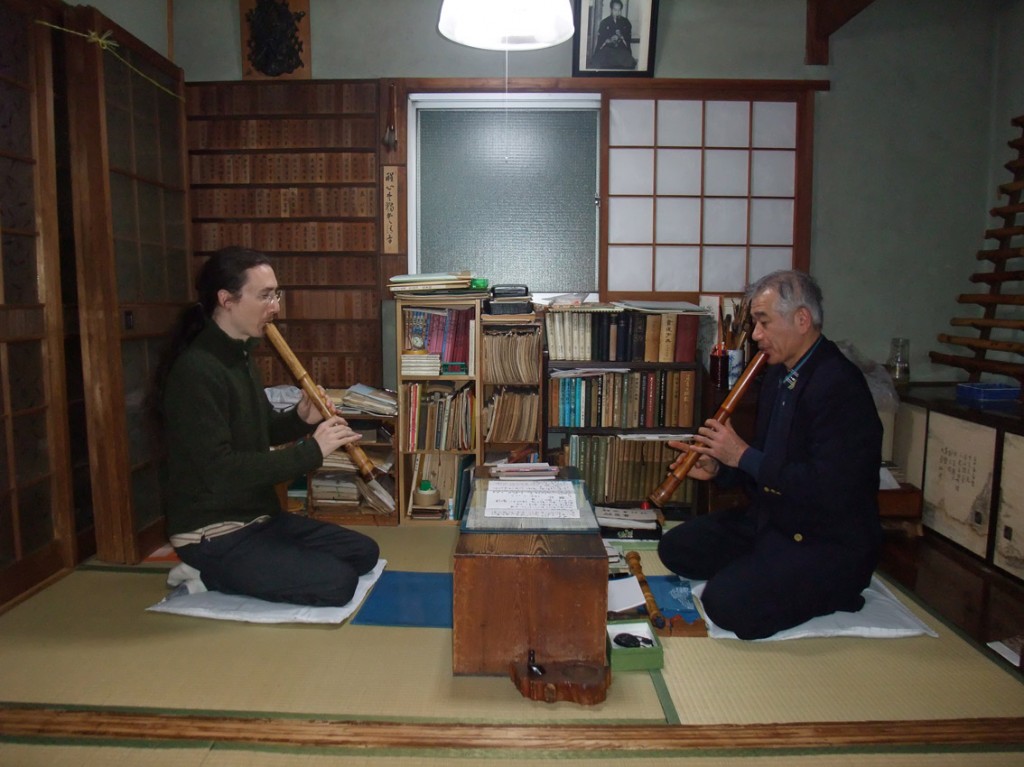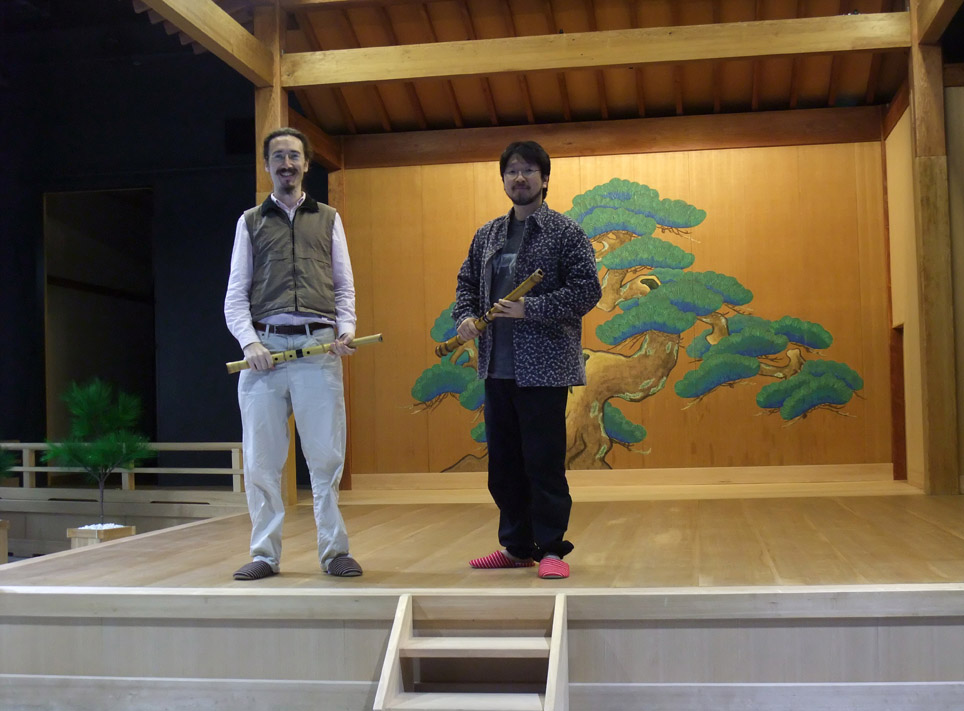Kimpu Ryu (sometimes spelled Kinpu Ryu also known as Nezasa Ha, see bottom of the page regarding this name), is the style of shakuhachi playing which has its roots in the samurai community of Tsugaru, in the far North of Japan. This school was formalized by Nyui Getsuei in 1884 who became the first official iemoto of the school. Among his students there were three who became especially renowned as the three great players of Kimpu Ryu: Orito Nyogetsu, Tsushima Kosho and Nagano Kyokuei.
Justin first studied Kimpu Ryu in Chikushinkai which have the first two Kimpu Ryu pieces, Shirabe and Sagariha, through Watazumi’s transmission. Watazumi’s versions are excellant, however the style is quite unique to Watazumi and very much affected by the other styles which he played. In search of a more regionally distinct Kimpu Ryu style, Justin was glad to study Tsushima Kosho’s style with Fujiyoshi Etsuzan. Etsuzan taught some key points of Kimpu Ryu’s unique way of playing, and the beauty of Tsushima’s elegant style.
Justin later studied with Otsubo Shido and Sato Jokan. Jokan was the principle student of Jin Nyodo, who was famous for his native Kimpu Ryu playing. He is an outstanding player of this style, teaching both the regular pieces and in their alternate keys.
Otsubo Shido is the inheritor of Sato Reido’s Kimpu Ryu lineage. Sato Reido studied from both Kiyota Shodo and Yamaue Getsuzan, both of whose schools he inherited as their principal student. Yamaue studied the complete Kimpu Ryu repertoire from a total of 4 teachers, and several of the pieces from one more teacher. His primary teacher however was Orito Nyogetsu, with whom he studied from 1927 to 1940. Sato Reido was one of only two students to receive this complete lineage of Orito’s Kimpu Ryu from Yamaue. In honour of this, Yamaue also passed on to Reido a shakuhachi made by Orito himself. Justin studied this complete repertoire in Orito’s style from Otsubo Shido.
Justin’s style retains overtones of delicacy from Tsushima Kosho’s style while taking the main character of vigour and ornament from Orito Nyogetsu’s style.
Listen to Justin playing Kimpu Shirabe, the first piece in the Kimpu Ryu repertoire:
Kimpu Ryu Lineage Chart:
The following chart shows an extract of the lineage of transmission of the Kimpu Ryu honkyoku repertoire, from Nyui Getsuei to his three principle students Orito Nyogetsu, Tsushima Kosho and Nagano Kyokuei. Although he had many other students, this chart includes only one more, Sasamori, who was Jin Nyodo’s teacher, as well as a few of the more famous members of other schools (Aoki and Shigemi were from Kinko Ryu) who also learned and transmitted the Kimpu Ryu repertoire.
In 2010 Justin became friends with Takahashi Chosetsu, a shakuhachi player from Hirosaki, the home of Kimpu Ryu. Takahashi studied from Tsushima Kosho’s lineage, but also from Goto Seizo, whose lineage does not come from Nyui Getsuei (see the above chart). In 2013 Justin had the pleasure of visiting Takahashi to discuss in depth the differences between these lineages.
“It seems that Kimpu Ryu, rare though it is, may perhaps be more often heard outside of its native Aomori than in, scattered as it is across Japan. And so, having mainly trained in Kyushu myself, I was curious what the state of Kimpu Ryu might be, in Northern Japan. It was a great joy to see my friend Takahashi Chosetsu again and to play together, and realise how close our styles are. The gentle warmth of Tsushima Kosho’s style was evident, and the specifics of finger techniques and oral instructions from the two lineages he has received showed the depth of his study and practice.
While there are some small, delightful variations on some ornaments, it was a great joy to experience such harmony between the styles we have learned, so easy to play together, even though our lineages have been apart for several generations. It was as if in a foreign land surrounded by foreign words, chancing upon an old friend from ones home village with whom one can joyfully speak together the village dialect. I look forward to playing together more in future.” – Justin Senryu
Regarding the name ‘Nezasa Ha’:
Kimpu Ryu is also known as ‘Nezasa Ha’, or ‘Kimpu Ryu Nezasa Ha’. There is also mention in an ancient document dated 1628 of a ‘Nezasa-ha’ listed as one of the sub-sects of the Fuke sect of Zen Buddhism. [It was written in some 20th Century articles that the 1628 document mentioned Nezasa Ha, but a friend and colleague of Justin’s has called even this into question now, so please check here again soon for an update as various sources are consulted].
It has been said that the current ‘Nezasa Ha’ of Aomori is the same Nezasa Ha which is referred to in this ancient document. The source of this claim is based on the assumption that Yoshizaki Kodo’s teacher Kurihara Kimpu had accompanied Kesshu Kanga to Ichigetsu-ji in Edo, from Enpo-ji, and that Kesshu Kanga was “the cheif priest of Enpo-ji”, a Fuke temple in Gunma Prefecture associated with the ancient Nezasa Ha sect. They are therefore said, according to this story, to have been Nezasa Ha honkyoku players, and to have transmitted the Nezasa Ha honkyoku to Yoshizaki.
This story has often been repeated. However, it seems that it can be traced back no further than the 20th century. Although it gives a convenient explanation as to connecting the name ‘Nezasa Ha’ used in Aomori, with the same name appearing in the ancient document, there is a problem with this theory. Firstly there is neither any notation nor any record of even the names of any pieces the ancient Nezasa Ha had in its repertoire. Secondly, there is no document to show the name or mention of any honkyoku outside of the Kinko Ryu repertoire which Kesshu Kanga or Kurihara Kimpu may have taught or played, nor even that they did teach or play any.
It appears that the story assumes this transmission took place merely because Kesshu was from Enpo-ji temple, and that this temple had belonged to the Nezasa Ha of the ancient document. But here lies the greatest problem with this story, since, Kesshu was in fact not from Enpo-ji temple in Gunma, but from Saiko-ji temple in Kanagawa where he served as ‘jushoku’, before moving to Ichigetsu-ji. This is documented in a branch monastery of Saiko-ji, where it is quite literally carved in stone. Therefore, aside from the name being the same, there seems no reason for assuming any direct connection between the Nezasa Ha of Aomori (aka. Kimpu Ryu) and the Nezasa Ha mentioned in the ancient document mentioned above.
What we do know about the history of the Kimpu Ryu honkyoku is in fact very little. There were no Fuke temples in Aomori, so, unlike the rest of the honkyoku in the Edo period, this was a lay community of honkyoku players. We do know that members of the school came to study in Edo in the home temples of the Kinko Ryu, and we can assume that komuso from Oshu and perhaps elsewhere would have visited Aomori from time to time. Notation was written for the 10 pieces which make up the standard Kimpu Ryu repertoire in the Meiji period, but before that, the musical history for now remains a mystery.



